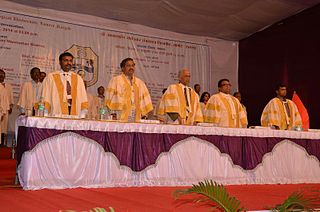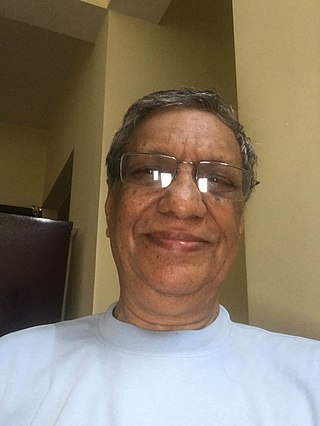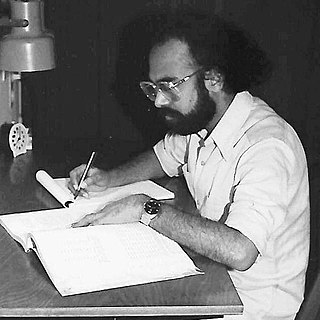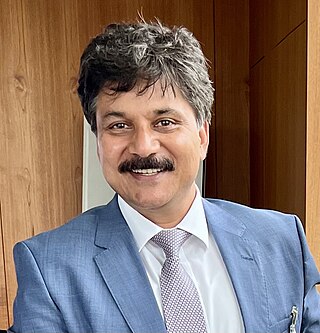
Man Mohan Sharma is an Indian chemical engineer. He was educated at Jodhpur, Mumbai, and Cambridge. At age 27, he was appointed Professor of Chemical Engineering in the Institute of Chemical Technology, Mumbai. He later went on to become the Director of UDCT, the first chemical engineering professor to do so from UDCT.

The Council of Scientific and Industrial Research is a research and development (R&D) organisation in India to promote scientific, industrial and economic growth. Headquartered in New Delhi, it was established as an autonomous body in 1942 under the aegis of the Department of Scientific and Industrial Research (DSIR), Ministry of Science and Technology, Government of India. CSIR is among the largest publicly funded R&D organisations in the world. CSIR has pioneered sustained contribution to science and technology (S&T) human resource development in India.
Stanley Donald Stookey was an American inventor. He had 60 patents in his name related to glass and ceramics, some patents solely his and others shared as joint patents with other inventors. His discoveries and inventions have contributed to the development of ceramics, eyeglasses, sunglasses, cookware, defense systems, and electronics.

The American Ceramic Society (ACerS) is a nonprofit organization of professionals for the ceramics community, with a focus on scientific research, emerging technologies, and applications in which ceramic materials are an element. ACerS is located in Westerville, Ohio.

Prem Chand Pandey is an Indian space scientist, planetary scientist, and academic in the fields of satellite oceanography, remote sensing, atmospheric science, the Antarctic and climate change, and also he is the founding director of the National Centre for Polar and Ocean Research (NCPOR).
Girish S. Agarwal, Fellow of the Royal Society UK, is a theoretical physicist. He is currently at the Texas A & M University with affiliations to the Departments of Biological and Agricultural Engineering, Physics and Astronomy, and the Institute for Quantum Science and Engineering. Earlier he worked as Noble Foundation Chair and the Regents Professor at the Oklahoma State University. He is a recognized leader in the field of quantum optics and also has made major contributions to the fields of nonlinear optics, nanophotonics and plasmonics. In 2013 he published the textbook "Quantum Optics", covering a wide range of recent developments in the field, which has been well received by the community.

Institute of Chemical Technology (ICT) is a public deemed university in Mumbai, India. It is focused on training and research in the fields of chemical engineering, chemical technology, and pharmaceutical sciences. Established in 1933, the institute was granted deemed university status in 2008, making it the only state-funded deemed university in India. In 2018, ICT was named an institute with a special status per the Empowered Expert Committee and was given the status of Category 1 institute with graded autonomy by the Ministry of Human Resource Development and the University Grants Commission (India). The institute also has regional campuses at Bhubaneswar, Odisha and Jalna, Maharashtra.
Kevin Petrie is a practicing artist, author, and Professor of Glass and Ceramics at The National Glass Centre, University of Sunderland.
Bikramjit Basu is currently a full professor at Indian Institute of Science, Bangalore, specializing in Engineering Ceramics and Biomaterials Science. He was awarded the Shanti Swarup Bhatnagar Prize for science and technology, the highest science award in India, for the year 2013 in engineering science category. The prize was awarded for his "outstanding contributions encompassing theory and experiments to significantly expand our understanding of the in vitro cell functionality modulation on engineered bio-materials using electric field simulation approach". With a team of clinicians and entrepreneurs, he is actively involved in translating his research into implantable biomedical devices for orthopedic and dental restorative applications and currently leading a center of Excellence at IISc, Bangalore. In 2015, he received the National Bioscience award. Besides, Prof. Basu is also involved in development of Zirconum diboride based UHTCs.
Swapan Guha is an Indian entrepreneur and a Fellow of the Indian Institute of Ceramics, known for his expertise in ceramic industry. He was honored by the Government of India, in 2012, with the fourth highest Indian civilian award of Padma Shri.
Chaitanyamoy Ganguly is an Indian nuclear scientist and a former head of the Nuclear Fuel Cycle and Materials Section of the International Atomic Energy Agency (IAEA), credited with many innovations in the field of nuclear material science. He was honored by the government of India in 2002, with the fourth-highest Indian civilian award of Padma Shri.
Vishweshwaraiah Prakash is an Indian structural biologist, food technologist and a former director-general designate of the Council of Scientific and Industrial Research (CSIR). He is a former director of the Central Food Technological Research Institute (CFTRI), Mysore and was involved with the International Union of Food Science and Technology as the chairman of its International Academy during 2008-10. He received the Shanti Swarup Bhatnagar Prize, the highest Indian award in the science and technology category in 1996. The Government of India awarded him the fourth highest civilian honour of the Padma Shri in 2004,
Kalya Jagannath Rao, popularly known as K. J. Rao, is an Indian physical chemist and an Emeritus professor at the Indian Institute of Science. He is known for his researches on nanomaterials, amorphous Materials and ceramics and is an elected fellow of the Indian National Science Academy, National Academy of Sciences, India, International Academy of Ceramics, Asia Pacific Academy of Materials and World Innovation Foundation and the Indian Academy of Sciences. The Council of Scientific and Industrial Research, the apex agency of the Government of India for scientific research, awarded him the Shanti Swarup Bhatnagar Prize for Science and Technology, one of the highest Indian science awards, in 1984, for his contributions to chemical sciences. He is also a recipient of the Ordre des Palmes Académiques of the Government of France.

Prof. R K Sinha is the Vice Chancellor of Gautam Buddha University, Greater Noida, Gautam Budh Nagar under Uttar Pradesh Government since January 2022. He was the Director of the CSIR-Central Scientific Instruments Organisation (CSIR-CSIO) Sector-30C, Chandigarh-160 030, India. He has been a Professor - Applied Physics, Dean-Academic [UG] & Chief Coordinator: TIFAC-Center of Relevance and Excellence in Fiber Optics and Optical Communication, Mission REACH Program, Technology Vision-2020, Govt. of India Delhi Technological University Bawana Road, Delhi-110042, India.
Dwijesh Kumar Dutta Majumder INSA was a Professor Emeritus in the Computer and Communication Sciences Division of the Indian Statistical Institute, Kolkata and Honorary Director-Secretary of the Institute of Cybernetics Systems and Information Technology in the same city. He is also an Emeritus Scientist of the Council of Scientific & Industrial Research, operated by the Government of India.
Tilak Raj Sharma is an Indian plant biologist, the deputy director general (CS) of ICAR and former executive director and chief executive officer of the National Agri-Food Biotechnology Institute (NABI), and Center of Innovative and Applied Bioprocessing (CIAB) respectively, both autonomous institutes under the Department of Biotechnology. Known for his studies in the fields of genomics and plant disease resistance, Sharma is an elected fellow of the National Academy of Sciences, India, the National Academy of Agricultural Sciences and the Indian National Science Academy. In 2007, Sharma received the National Bioscience Award for Career Development from the Department of Biotechnology, recognizing his contributions to biosciences.
Alan Hywel Jones, usually Hywel Jones professionally, is a British materials scientist, working on ceramic composites and body armour, tribology, metals, including sustainable use of precious metals and rare-earth elements, and decorative alloys, wear-resistant coatings, materials analysis and ballistics, and friction-stir methods. He has appeared on radio and television to discuss some of his areas of interest.

Purushottam Chakraborty is an Indian physicist who is one of the renowned experts in materials analysis using ion beams and secondary ion mass spectrometry (SIMS).
John Ballato is an American materials scientist, entrepreneur, and academic. He holds the J. E. Sirrine Endowed Chair of Optical Fiber and is a professor of materials science and engineering, electrical and computer engineering, as well as physics and astronomy at Clemson University. He has received many international recognitions for his research on optical and optoelectronic materials, particularly as relates to optical fiber.

Sanjay Mathur is an inorganic chemist, current president of the American Ceramic Society. acting director of the Institute of Inorganic Chemistry at the University of Cologne, honorary co-director of the Institute of Renewable Energy Sources at the Xi'an Jiaotong University, a World Class University Professor at the Chonbuk University. He is an adjunct professor at the Indian Institutes of Technology in Chennai and has held visiting professorships at the Central South University, the Tokyo University of Agriculture and Technology, the National Institute of Science Education and Research. He was awarded the Honorary Doctorate of the Vilnius University in 2016. He is an elected fellow of the American Ceramic Society, the American Society for Metals, the European Science Academy, the Indian National Science Academy and has been awarded with the fellowships of the Alexander von Humboldt Foundation. Mathur is known for his library of single source precursors for the production of nanostructured ceramic materials with tailormade properties, attaining a h-index of 70 and over 18000 citations.








